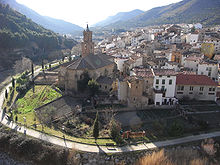Arnedillo
You can help expand this article with text translated from the corresponding article in Spanish. (August 2011) Click [show] for important translation instructions.
|
Arnedillo | |
|---|---|
 View of Arnedillo | |
Location within La Rioja. | |
| Coordinates: 42°12′43″N 2°14′09″W / 42.21194°N 2.23583°W | |
| Country | |
| Autonomous community | |
| Comarca | Arnedo |
| Government | |
| • Mayor | Pedro Antonio Montalvo Íñigo (PSOE) |
| Area | |
| • Total | 48.33 km2 (18.66 sq mi) |
| Elevation | 1,057 m (3,468 ft) |
| Population (2018)[1] | |
| • Total | 426 |
| Demonym | arnedillense |
| Postal code | 26589 |
| Website | www |
Arnedillo is a village in the province and autonomous community of La Rioja, Spain. It is crossed by the Cidacos River. The municipality covers an area of 48.33 square kilometres (18.66 sq mi) and as of 2011 had a population of 477 people.[2]
Arnedillo is famous for its hot springs, which emerge on the surface after being filtered at a temperature of about 50°C (125°F). There is a hot springs resort known as "Balneario de Arnedillo", which attracts many people to this small village.
Another tourist attraction are the footprints of dinosaurs that can be found near Arnedillo.
History
[edit]The origin of the village dates back to the Tenth Century.
Places of Interest
[edit]Buildings and monuments
[edit]
- Castle Bridge.
- Castle.
- Saint Servando and Saint German Church.


- Hermitages: Saint Tirso, Peñalba, Virgin of the Tower, Saint Andrew, Saint Michael, Santiago, Saint Zoilo.
Hot Springs
[edit]The municipality is well known for its thermal waters, which flow through several springs. Some of them are leveraged by the village's resort known as "Balneario de Arnedillo", and others are opened to everyone and they are known as "Pozas".
Other places of Interest
[edit]- Footprints of dinosaurs.
- Snowfield.
- The vulture's viewpoint.
- Wind farm.
References
[edit]- ^ Municipal Register of Spain 2018. National Statistics Institute.
- ^ "La Rioja: Población por municipios y sexo:Cifras oficiales de población resultantes de la revisión del Padrón municipal a 1 de enero de 2011". Instituto Nacional de Estadística. Archived from the original on 21 May 2012. Retrieved 27 May 2012.



